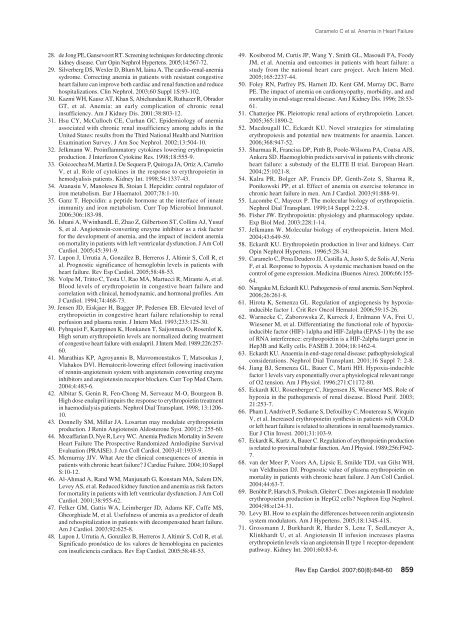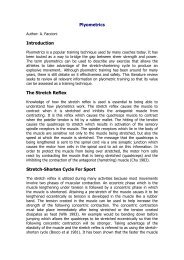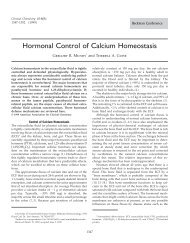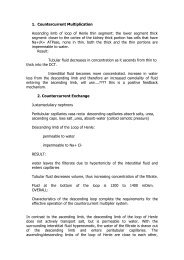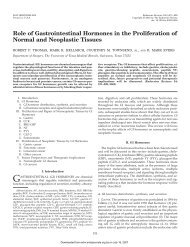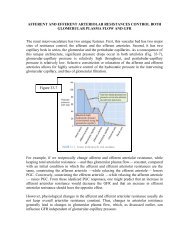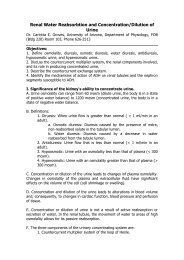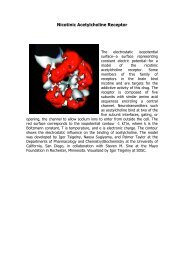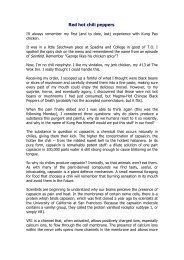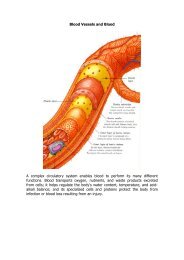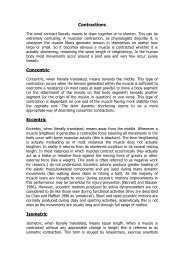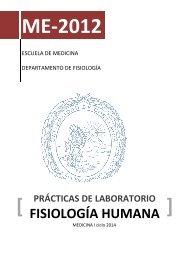Anemia in Heart Failure: Pathophysiology, Pathogenesis, Treatment ...
Anemia in Heart Failure: Pathophysiology, Pathogenesis, Treatment ...
Anemia in Heart Failure: Pathophysiology, Pathogenesis, Treatment ...
Create successful ePaper yourself
Turn your PDF publications into a flip-book with our unique Google optimized e-Paper software.
Caramelo C et al. <strong>Anemia</strong> <strong>in</strong> <strong>Heart</strong> <strong>Failure</strong>28. de Jong PE, Gansevoort RT. Screen<strong>in</strong>g techniques for detect<strong>in</strong>g chronickidney disease. Curr Op<strong>in</strong> Nephrol Hypertens. 2005;14:567-72.29. Silverberg DS, Wexler D, Blum M, Ia<strong>in</strong>a A. The cardio-renal-anemiasydrome. Correct<strong>in</strong>g anemia <strong>in</strong> patients with resistant congestiveheart failure can improve both cardiac and renal function and reducehospitalizations. Cl<strong>in</strong> Nephrol. 2003;60 Suppl 1S:93-102.30. Kazmi WH, Kausz AT, Khan S, Abichandani R, Ruthazer R, ObradorGT, et al. <strong>Anemia</strong>: an early complication of chronic renal<strong>in</strong>sufficiency. Am J Kidney Dis. 2001;38:803-12.31. Hsu CY, McCulloch CE, Curhan GC. Epidemiology of anemiaassociated with chronic renal <strong>in</strong>sufficiency among adults <strong>in</strong> theUnited States: results from the Third National Health and NutritionExam<strong>in</strong>ation Survey. J Am Soc Nephrol. 2002;13:504-10.32. Jelkmann W. Pro<strong>in</strong>flammatory cytok<strong>in</strong>es lower<strong>in</strong>g erythropoiet<strong>in</strong>production. J Interferon Cytok<strong>in</strong>e Res. 1998;18:555-9.33. Goicoechea M, Mart<strong>in</strong> J, De Sequera P, Quiroga JA, Ortiz A, CarreñoV, et al. Role of cytok<strong>in</strong>es <strong>in</strong> the response to erythropoiet<strong>in</strong> <strong>in</strong>hemodyalisis patients. Kidney Int. 1998;54:1337-43.34. Atanasiu V, Manolescu B, Stoian I. Hepcid<strong>in</strong>: central regulator ofiron metabolism. Eur J Haematol. 2007;78:1-10.35. Ganz T. Hepcid<strong>in</strong>: a peptide hormone at the <strong>in</strong>terface of <strong>in</strong>nateimmunity and iron metabolism. Curr Top Microbiol Immunol.2006;306:183-98.36. Ishani A, Ww<strong>in</strong>handL E, Zhao Z, Gilbertson ST, Coll<strong>in</strong>s AJ, YusufS, et al. Angiotens<strong>in</strong>-convert<strong>in</strong>g enzyme <strong>in</strong>hibitor as a risk factorfor the development of anemia, and the impact of <strong>in</strong>cident anemiaon mortality <strong>in</strong> patients with left ventricular dysfunction. J Am CollCardiol. 2005;45:391-9.37. Lupon J, Urrutia A, González B, Herreros J, Altimir S, Coll R, etal. Prognostic significance of hemoglob<strong>in</strong> levels <strong>in</strong> patients withheart failure. Rev Esp Cardiol. 2005;58:48-53.38. Volpe M, Tritto C, Testa U, Rao MA, Martucci R, Mirante A, et al.Blood levels of erythropoiet<strong>in</strong> <strong>in</strong> congestive heart failure andcorrelation with cl<strong>in</strong>ical, hemodynamic, and hormonal profiles. AmJ Cardiol. 1994;74:468-73.39. Jensen JD, Eiskjaer H, Bagger JP, Pedersen EB. Elevated level oferythropoiet<strong>in</strong> <strong>in</strong> congestive heart failure relationship to renalperfusion and plasma ren<strong>in</strong>. J Intern Med. 1993;233:125-30.40. Fyhrquist F, Karpp<strong>in</strong>en K, Honkanen T, Saijonmaa O, Rosenlof K.High serum erythropoiet<strong>in</strong> levels are normalized dur<strong>in</strong>g treatmentof congestive heart failure with enalapril. J Intern Med. 1989;226:257-60.41. Marathias KP, Agroyannis B, Mavromoustakos T, Matsoukas J,Vlahakos DVl. Hematocrit-lower<strong>in</strong>g effect follow<strong>in</strong>g <strong>in</strong>activationof renn<strong>in</strong>-angiotens<strong>in</strong> system with angiotens<strong>in</strong> convert<strong>in</strong>g enzyme<strong>in</strong>hibitors and angiotens<strong>in</strong> receptor blockers. Curr Top Med Chem.2004;4:483-6.42. Albitar S, Gen<strong>in</strong> R, Fen-Chong M, Serveauz M-O, Bourgeon B.High dose enalapril impairs the response to erythropoiet<strong>in</strong> treatment<strong>in</strong> haemodialysis patients. Nephrol Dial Transplant. 1998; 13:1206-10.43. Donnelly SM, Millar JA. Losartan may modulate erythropoiet<strong>in</strong>production. J Ren<strong>in</strong> Angiotens<strong>in</strong> Aldosterone Syst. 2001;2: 255-60.44. Mozaffarian D, Nye R, Levy WC. <strong>Anemia</strong> Predicts Mortality <strong>in</strong> Severe<strong>Heart</strong> <strong>Failure</strong> The Prospective Randomized Amlodip<strong>in</strong>e SurvivalEvaluation (PRAISE). J Am Coll Cardiol. 2003;41:1933-9.45. Mcmurray JJV. What Are the cl<strong>in</strong>ical consequences of anemia <strong>in</strong>patients with chronic heart failure? J Cardiac <strong>Failure</strong>. 2004;10 SupplS:10-12.46. Al-Ahmad A, Rand WM, Manjunath G, Konstam MA, Salem DN,Levey AS, et al. Reduced kidney function and anemia as risk factorsfor mortality <strong>in</strong> patients with left ventricular dysfunction. J Am CollCardiol. 2001;38:955-62.47. Felker GM, Gattis WA, Leimberger JD, Adams KF, Cuffe MS,Gheorghiade M, et al. Usefulness of anemia as a predictor of deathand rehospitalization <strong>in</strong> patients with decompensated heart failure.Am J Cardiol. 2003;92:625-8.48. Lupon J, Urrutia A, González B, Herreros J, Altimir S, Coll R, et al.Significado pronóstico de los valores de hemoblog<strong>in</strong>a en pacientescon <strong>in</strong>suficiencia cardiaca. Rev Esp Cardiol. 2005;58:48-53.49. Kosiborod M, Curtis JP, Wang Y, Smith GL, Masoudi FA, FoodyJM, et al. <strong>Anemia</strong> and outcomes <strong>in</strong> patients with heart failure: astudy from the national heart care project. Arch Intern Med.2005;165:2237-44.50. Foley RN, Parfrey PS, Harnett JD, Kent GM, Murray DC, BarrePE. The impact of anemia on cardiomyopathy, morbidity, and andmortality <strong>in</strong> end-stage renal disease. Am J Kidney Dis. 1996; 28:53-61.51. Chatterjee PK. Pleiotropic renal actions of erythropoiet<strong>in</strong>. Lancet.2005;365:1890-2.52. Macdougall IC, Eckardt KU. Novel strategies for stimulat<strong>in</strong>gerythropoiesis and potential new treatments for anaemia. Lancet.2006;368:947-52.53. Sharmaa R, Francisa DP, Pittb B, Poole-Wilsona PA, Coatsa AJS,Ankera SD. Haemoglob<strong>in</strong> predicts survival <strong>in</strong> patients with chronicheart failure: a substudy of the ELITE II trial. European <strong>Heart</strong>.2004;25:1021-8.54. Kalra PR, Bolger AP, Francis DP, Genth-Zotz S, Sharma R,Ponikowski PP, et al. Effect of anemia on exercise tolerance <strong>in</strong>chronic heart failure <strong>in</strong> men. Am J Cardiol. 2003;91:888-91.55. Lacombe C, Mayeux P. The molecular biology of erythropoiet<strong>in</strong>.Nephrol Dial Transplant. 1999;14 Suppl 2:22-8.56. Fisher JW. Erythropoiet<strong>in</strong>: physiology and pharmacology update.Exp Biol Med. 2003;228:1-14.57. Jelkmann W. Molecular biology of erythropoiet<strong>in</strong>. Intern Med.2004;43:649-59.58. Eckardt KU. Erythropoiet<strong>in</strong> production <strong>in</strong> liver and kidneys. CurrOp<strong>in</strong> Nephrol Hypertens. 1996;5:28-34.59. Caramelo C, Pena Deudero JJ, Castilla A, Justo S, de Solis AJ, NeriaF, et al. Response to hypoxia. A systemic mechanism based on thecontrol of gene expression. Medic<strong>in</strong>a (Buenos Aires). 2006;66:155-64.60. Nangaku M, Eckardt KU. <strong>Pathogenesis</strong> of renal anemia. Sem Nephrol.2006;26:261-8.61. Hirota K, Semenza GL. Regulation of angiogenesis by hypoxia<strong>in</strong>duciblefactor 1. Crit Rev Oncol Hematol. 2006;59:15-26.62. Warnecke C, Zaborowska Z, Kurreck J, Erdmann VA, Frei U,Wiesener M, et al. Differentiat<strong>in</strong>g the functional role of hypoxia<strong>in</strong>duciblefactor (HIF)-1alpha and HIF-2alpha (EPAS-1) by the useof RNA <strong>in</strong>terference: erythropoiet<strong>in</strong> is a HIF-2alpha target gene <strong>in</strong>Hep3B and Kelly cells. FASEB J. 2004;18:1462-4.63. Eckardt KU. Anaemia <strong>in</strong> end-stage renal disease: pathophysiologicalconsiderations. Nephrol Dial Transplant. 2001;16 Suppl 7: 2-8.64. Jiang BJ, Semenza GL, Bauer C, Marti HH. Hypoxia-<strong>in</strong>duciblefactor 1 levels vary exponentially over a physiological relevant rangeof O2 tension. Am J Physiol. 1996;271:C1172-80.65. Eckardt KU, Rosenberger C, Jürgensen JS, Wiesener MS. Role ofhypoxia <strong>in</strong> the pathogenesis of renal disease. Blood Purif. 2003;21:253-7.66. Pham I, Andrivet P, Sediame S, Defouilloy C, Moutereau S, Wirqu<strong>in</strong>V, et al. Increased erythropoiet<strong>in</strong> synthesis <strong>in</strong> patients with COLDor left heart failure is related to alterations <strong>in</strong> renal haemodynamics.Eur J Cl<strong>in</strong> Invest. 2001;31:103-9.67. Eckardt K, Kurtz A, Bauer C. Regulation of erythropoiet<strong>in</strong> productionis related to proximal tubular function. Am J Physiol. 1989;256:F942-7.68. van der Meer P, Voors AA, Lipsic E, Smilde TDJ, van Gilst WH,van Veldhuisen DJ. Prognostic value of plasma erythropoiet<strong>in</strong> onmortality <strong>in</strong> patients with chronic heart failure. J Am Coll Cardiol.2004;44:63-7.69. Benöhr P, Harsch S, Proksch, Gleiter C. Does angiotens<strong>in</strong> II modulateerythropoiet<strong>in</strong> production <strong>in</strong> HepG2 cells? Nephron Exp Nephrol.2004;98:e124-31.70. Levy BI. How to expla<strong>in</strong> the differences between ren<strong>in</strong> angiotens<strong>in</strong>system modulators. Am J Hypertens. 2005;18:134S-41S.71. Grossmann J, Burkhardt R, Harder S, Lenz T, SedLmeyer A,Kl<strong>in</strong>khardt U, et al. Angiotens<strong>in</strong> II <strong>in</strong>fusion <strong>in</strong>creases plasmaerythropoiet<strong>in</strong> levels via an angiotens<strong>in</strong> II type 1 receptor-dependentpathway. Kidney Int. 2001;60:83-6.Rev Esp Cardiol. 2007;60(8):848-60 859


